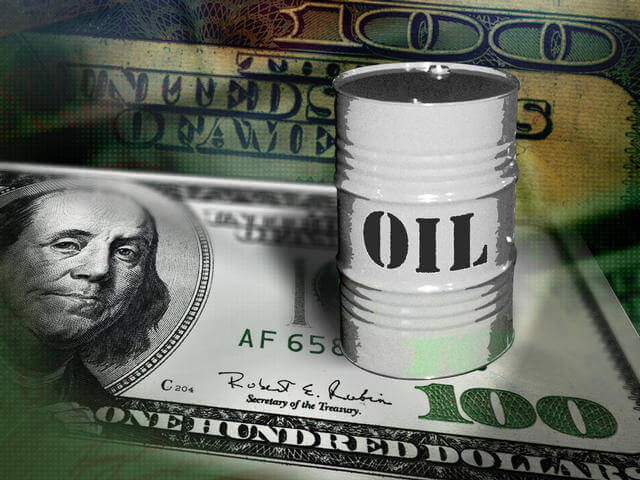Tag Archive for: oil
Energy, materials lead Wall Street gains as oil jumps
/NewsWall Street was higher on Monday as prices of crude oil and other commodities surged, pointing to an uptick in investors’ risk appetite following a rout in global markets.
Crude prices were up more than 5 percent after data showed a fall in U.S. rig counts and the International Energy Agency said it expects U.S. shale oil output to fall.
Prices of industrial metals such as Copper and Zinc were also up as investors worried about potential shortages.
Still, oil prices are hovering near levels last seen in 2003, with investors weighing the impact of a potential wave of defaults from energy companies on the financial sector.
Chevron’s (CVX.N) 1.4 percent rise provided the biggest boost to the energy sector .SPNY.
The S&P financial sector .SPSY, which has been the worst performer among the 10 major sectors this year, was up 1.79 percent on Monday as bank stocks recovered slightly.
“You’ve seen oil rebound today, which people are viewing very much as a kind of a green flag in the short-term to take on risk again to a certain degree,” said James Abate, chief investment office of Centre Funds in New York.
Abate, however, cautioned Monday’s gains should not be seen as the start of a long-term recovery.
“To me, this continues to be a counter-trend rally in the context of an intermediate to longer-term decline in the stock market. Our view is that this is nowhere near the resumption of a bull market,” he said.
At 9:37 a.m. ET (1437 GMT), the Dow Jones industrial average .DJI was up 179.29 points, or 1.09 percent, at 16,571.28, the S&P 500 .SPX was up 22.75 points, or 1.19 percent, at 1,940.53 and the Nasdaq Composite index .IXIC was up 52.02 points, or 1.15 percent, at 4,556.45.
All 10 major S&P sectors were higher, led by a 2 percent rise in both energy .SPNY and materials .SPLRCM sectors.
Investors are also keeping a close eye on the U.S. Federal Reserve for its next move on interest rates.
While Fed Chair Janet Yellen has indicated the central bank would stick to its rate hike program, policymakers appear at odds and traders have all but given up on a hike this year.
Shares of Fitbit (FIT.N) were up 4 percent at $16.24 ahead of its results later in the day.
Lumber Liquidators (LL.N) was down 20.8 percent at $11.26 after a report showed people exposed to some types of the company’s laminate flooring were more likely to get cancer than previously estimated.
Advancing issues outnumbered decliners on the NYSE by 2,487 to 279. On the Nasdaq, 1,906 issues rose and 375 fell.
The S&P 500 index showed 13 new 52-week highs and no new lows, while the Nasdaq recorded 24 new highs and nine lows.
Copyright: Reuters
Oil extends rally to $35 after Iran welcomes output freeze
/NewsOil rose to $35 a barrel on Thursday after Iran welcomed plans by Russia and Saudi Arabia to freeze output and an industry report showed a surprise drop in U.S. inventories.
The gain added to a more than 7 percent surge in the previous session, which came even though analysts said the market had overreacted to Iran’s support for the caps and the Russian-Saudi move would not likely reduce the global surplus.
Brent LCOc1 rose 60 cents to $35.10 a barrel by 1248 GMT, having closed 7.2 percent higher in the previous session. U.S. crude CLc1 gained 65 cents to $31.31.
“It’s a continuation of yesterday’s move,” said Carsten Fritsch, analyst at Commerzbank. “What we see still is extreme volatility. I would not be surprised to see prices retreating again by a big margin in coming days.”
Iranian Oil Minister Bijan Zanganeh met counterparts from Venezuela, Iraq and Qatar on Wednesday but did not say whether Iran would cap its output in keeping with the move by Russia and Saudi Arabia.

Copyright: Reuters
Saudi Arabia, Venezuela talk of co-operation to stabilize oil market
/NewsSaudi Arabia’s oil minister Ali al-Naimi discussed cooperation between OPEC members and other oil producers to stabilize the global oil market with his Venezuelan counterpart on Sunday, state news agency SPA reported.
Venezuela’s Oil Minister Eulogio Del Pino, who is on a tour of oil producers to lobby for action to prop up prices, said his meeting with Naimi was “productive”, his ministry reported.
Cash-strapped OPEC member Venezuela has been calling for an emergency meeting of producers to discuss steps to prop up prices, which are close to their lowest since 2003.
The prospect of supply restraint by the Organization of the Petroleum Exporting Countries and rivals helped oil prices LCOc1 rise above $34 a barrel on Friday from a 12-year low close to $27 last month, despite widespread scepticism that a deal will happen.
“It was a successful meeting and (conducted) in a positive atmosphere,” SPA cited Naimi as saying.
Both ministers discussed Del Pino’s visits to other oil producers and the outcome of his “meetings that aim towards the cooperation of those countries to stabilize the international oil market”, Naimi said.
“During the meeting, there were discussions about the cooperation of the producing countries within OPEC and outside (OPEC)… and the importance of the continuation of such consultations,” SPA added.
However, the comments by Saudi Arabia, the world’s largest oil exporter, show no indication of a shift in the country’s policy of refusing to cut supplies to prop up crude prices, some OPEC delegates said.
“They seem like just general talk about cooperation, but nothing about cutting production,” said one OPEC source.
“It’s always good to say discussions were positive and productive. Never say they were negative. The issue is not with Venezuela, it is with Iran,” said another OPEC source.
Sources familiar with the matter say Iran is reluctant to restrain crude supply as it wants to recover the market share it lost during sanctions that were imposed in 2012 because of its nuclear program. International sanctions were lifted in January.
OPEC oil production jumped to its highest in recent history in January as Iran increased sales and its rivals Saudi Arabia and Iraq also boosted supply, a Reuters survey showed.
Last Wednesday, the Iranian news agency Shana quoted Del Pino as saying six producing countries, including OPEC members Iran and Iraq and non-members Russia and Oman, supported a producer meeting.
But so far, none of OPEC’s Gulf members, including OPEC heavyweight Saudi Arabia, has publicly backed a meeting.
Copyright: Reuters
Why Cheap Oil Prices Could Be Bad for the Global Economy
/NewsDrivers are rejoicing over historically low prices at the pump.Yet while cheap gas prices are great for household budgets, they could indicate big trouble for the global economy, some economists say.
Markets around the world rely heavily on emerging economies—which, with the exception of China and India, are rich in oil and commodities, Bloomberg explained. These countries make up about 40 percent of global gross domestic product, double that in 1990.
Some of these markets, including oil-rich Russia and Saudi Arabia, are experiencing slow, and even shrinking, economic growth due to plunging oil prices. (Low oil prices are what’s responsible for low consumer gas prices.) Other markets, such as Nigeria, Suriname and Azerbaijan, have a high risk of default. Venezuela, one of the top 10 oil exporters, is considered one of the most likely default candidates. Its bonds maturing in 2022 are supposed to yield more than 40%, while in 2013, the yield was less than 10%, Bloomberg reported.
The slowdown has also extended to other industries, with Apple blaming weaker sales in the fourth quarter of 2015 on lagging economic growth in some emerging oil-rich nations. At the same time, however, consumers around the globe should have more disposable income because of what they’re saving thanks to cheaper fuel, heating, and energy costs. Some analysts maintain that this increase in disposable income should boost spending in other areas and keep the economy humming along.
Still, the changing demographics of oil production could hurt the global economy. While in the past the loss to exporters was bolstered by importers’ gains, the U.S. now competes with Saudi Arabia and Russia for the title of the world’s largest oil producer.
“Many oil exporters face very difficult circumstances,” Gian Maria Milesi-Ferretti, the IMF’s deputy director of research, told Bloomberg. “So now they have to cut spending significantly, and this will have an impact on economic growth.”
Copyright: Time
Oil price faces fresh downturn as Russia, Saudi tussle in Europe
/NewsA sales push by Saudi Arabia into north Europe’s refineries, a step into rival Russia’s backyard, piles fresh pressure on oil prices already struggling against oversupply.
Stung by Russia’s success in supplanting it in the giant Chinese market, Riyadh has embarked on a charm offensive in Europe, cutting its prices for December by more than it has in any other region to their lowest since 2009 during the financial crisis.
Saudi Arabian barrels rarely venture north of the Mediterranean, into the home turf for Russian, African and North Sea crudes. As a result, the kingdom’s success in luring away buyers of rival Russian Urals crude in Poland and Sweden is having an outsized knock-on impact on the market for a wide range of other crudes in the region.
Refiners averted a price drop from a similar build up of surplus oil in spring, snapping up cheaper crude to feed a surge in gasoline demand.
But this time there is a glut of refined fuel too. The crude
surplus is matched by an overhang in oil products which means refineries will not be able to come to the rescue by absorbing the extra.
“The first half of next year looks like a distinctly dangerous period for oil bulls,” brokers PVM Chief Executive David Hufton said in a note.
“It could be the period when tank tops are reached, leading to a price meltdown.”
Homeless barrels are again collecting in the Atlantic market, this time dragging crudes of all kind into a price war that is making $50 a barrel an increasingly impenetrable barrier for benchmark Brent futures.
“There isn’t any denying that the fundamentals are pretty bearish,” said Citi analyst Chris Main. “You’ve got an overhang of cargoes, and it will weigh on the benchmark.”
Saudi Arabia’s fresh European sales have displaced only a small amount of Urals, a heavy grade that has not faced much threat from the year’s excess that has centred on lighter U.S. shale oil. But they suggest a new front in the battle for market share between the two giant producers.
Saudi oil minister Ali al-Naimi on Sunday said demand for oil worldwide would soon reflect the attractiveness of current prices, noting Asia as key to the growth.
URALS HEADS EAST
Russia’s post-Soviet high of 10.78 million barrels per day (bpd) of oil production helped triple the discount of Urals versus dated Brent in just three months to reach 17-month lows.
And as Iran prepares to ramp up sales when and if Western sanctions are lifted next year, the overhang is only likely to aggravate further. BFO-URL-NWE
Discounted Urals cargoes are now muscling out British Forties crude, the largest of the four North Sea streams that make up the dated Brent benchmark.
At least three of the seven supertanker (VLCC) fixtures booked from the North Sea to Asia in November are loading Russian, rather than the North Sea crudes that typically sail.
“What is amazing is to see Forties is still pretty weak despite all the barrels that are going to the Far East,” Petromatrix analyst Olivier Jakob said. “If we did not have those VLCCs going to Asia, it would be a bloodbath.”
Forties price differentials are close to their lowest in five months, having traded at a discount to the dated Brent benchmark more often in 2015 than at any time in the last 20 years, and differentials for a string of crude oil grades now stand at multi-month lows.
Azeri crude price differentials have also more than halved over the past month to an annual low, while premiums for Nigeria’s Qua Iboe have also lost half their value.
A physical excess of more than 60 million barrels of Nigerian oil, and North Sea output at two-year highs, along with nearly full diesel, gasoil and jet fuel tanks in Europe that have already pushed cargoes into floating storage, will only add to the pressure.
Copyright: Reuters
Oil at $50 Is ‘Gift to World’ as Abu Dhabi Sees Higher Prices
/NewsOil at $50 a barrel is a “gift to the world” as prices should be low enough to spur economic growth, according to the head of Abu Dhabi’s Department of Economic Development.
Prices will probably be at $60 next year, after hitting bottom at $45, Ali Al Mansoori, the department’s chairman, said in an interview Sunday in the capital of the United Arab Emirates, the fourth-largest oil producer in the Organization of Petroleum Exporting Countries. Benchmark Brent crude has dropped 16 percent this year amid a global oversupply and was trading Monday at $47.98 a barrel at 11:55 a.m. London time.
“It is a gift to the world that oil has dropped to $50,” Al Mansoori said. “Would we like for oil to stay at $50? Absolutely not. We would like oil to go to $70, $80, but beyond that I think it would hurt the economic growth.”
Oil demand growth will climb to a five-year high of 1.8 million barrels a day this year before slowing next year amid a weaker outlook for the world economy, the International Energy Agency forecast in its October market report. The market will probably remain oversupplied through 2016 as Iran exports more crude, should international sanctions be eased, it said.
‘Win-Win’
Oil at $50 to $60 a barrel is a “win-win situation” because it benefits consumers and producers alike, Al Mansoori said. For buyers, “it’s an opportunity for them now to use it as much as possible to set up their policies for economic growth in the next five years because ultimately the commodity is scarce.”
Declining oil prices will mean Abu Dhabi’s gross domestic product growth will be little changed next year, Al Mansoori said. The emirate is doing what it can to expand the economy, but “if we don’t, we take next year as a challenge and turn this challenge into opportunity and turn 2017 with strong growth,” he said.
Major projects in Abu Dhabi will continue. The Midfield Terminal Building at the Abu Dhabi International Airport is still slated to open in 2017, while a branch of the Louvre museum will open next year, Al Mansoori said. In addition, Al Mansoori said he’s meeting with architect Frank Gehry next month in Los Angeles to review the final design for the Guggenheim museum being built in Abu Dhabi, and move ahead with signing the museum’s contract.
The World’s Biggest Oil Companies
/NewsHow much has the shale boom shifted the rankings of the world’s 20 biggest oil and gas companies? We compared today’s giants with data from 2003 to see what, if anything, has changed for the likes of Exxon, Shell, BP, Saudi Aramco and Chevron. Who do you think is on top?
1. Saudi Aramco
2013: 12.7 million BOE per day (barrels of oil + natural gas equivalents)
2003: 9.9 million BOE per day (rank: 1)
Saudi Arabia’s Minister of Petroleum and Mineral Resources Ali Ibrahim Al-Naimi speaks to journalists at a hotel in in Vienna, Austria, on Monday, June 11, 2012. Al-Naimi joined Saudi Aramco in 1947, age 12, studied in the U.S., rose to become CEO and is now the world’s most powerful oilman. Data courtesy WoodMackenzie.
2. Gazprom
2013: 8.1 million BOE per day (oil + natural gas equivalents)
2003: 9.5 million BOE per day (rank: 2)
In this Tuesday, Nov. 12, 2013 photo, Russian President Vladimir Putin, right, talks with Russian state energy giant Gazprom CEO Alexey Miller during the cooperation signing ceremony between Russia and Vietnam at the Presidential Palace in Hanoi, Vietnam. Putin announced that Russia and Vietnam would be strengthening their energy and military ties. Data courtesy WoodMackenzie.
3. National Iranian Oil Company
2013: 6.1 million BOE per day (oil + natural gas equivalents)
2003: 4.9 million BOE per day (rank: 3)
Iran’s Minister of Petroleum, Rostam Ghasemi, gestures before the start of the 161st meeting of the OPEC in Vienna, on June 14, 2012. Despite international sanctions on its nuclear program, Iran has been able to grow its natural gas output. Data courtesy WoodMackenzie.
4. ExxonMobil
2013: 5.3 million BOE per day (oil + natural gas equivalents)
2003: 4.6 million BOE per day (rank: 4)
Russia’s President Vladimir Putin (R) and ExxonMobil Chairman and CEO Rex Tillerson (L) attend at the ceremony of the signing of an agreement between state-controlled Russian oil company Rosneft and ExxonMobil in the Black Sea port of Tuapse on June 15, 2012. Data courtesy WoodMackenzie.
Images Getty Images

Latest News
 Breaking Barriers and Building the Future18 March, 2025
Breaking Barriers and Building the Future18 March, 2025 Fundamental factors to strengthen Pemex12 August, 2019
Fundamental factors to strengthen Pemex12 August, 2019 Offshore Project Development: The Road to First Oil26 July, 2019
Offshore Project Development: The Road to First Oil26 July, 2019









